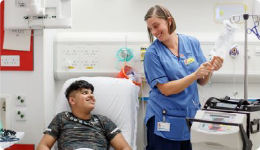After an injury your child can expect to feel pain and see swelling around the joint, in the coming days bruising may also develop.
Due to the pain and swelling it may be difficult for your child to take weight through that leg, bend or straighten the knee to start with but this should ease off within a few days.
If we have given your child a splint to wear they should try to use it only when absolutely needed and take if off regularly throughout the day.
If we have given your child crutches try to use them only when needed, they can try just using one before trying without any if they find that easier.
It is expected that your child will be able to walk normally within 1 week.
Normal walking means that your heel touches the ground first and you roll off of your toes before you lift the foot from the floor.
Sometimes it can take a little longer for swelling and bruising to settle, this is normal.











